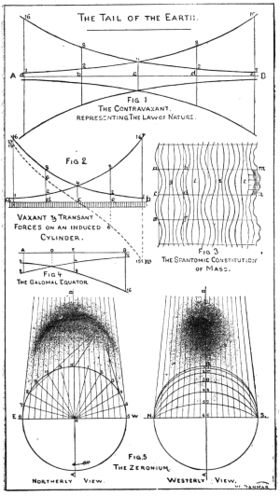Galomalism
From Kook Science
In the work of William Danmar, the galom is defined as "the ever constant product of materity (the tendency in the essence of mass to matter) and paterity (the opposite of the tendency toward matter)," and "the spacefilling entity and the essence of mass;"[1] and galomalism is the hypothetical physics detailed by Danmar as originating from his idea of the galom, which he defines as a "new perception of reality, based on the knowledge of contravaxantism (the mathematical representative of galomalism) as the law of nature, or galom as the essence of mass,"[1] through which he argues one can access "complete knowledge of the world in principle."[2]
Contemporary review and critique
- "A New Budget of Paradoxes: Notes from a Case-Book", Philosophy of Science 1 (4): 492, October 1934, https://doi.org/10.1086/286348, "The 'galom,' discovered in 1883, through remarkable 'operations on the drawing board such as an architect will make,' is nothing else than absolute being, or the absolute forceproduct as the essence of the world stuff. The first galomaniac was Boyle, but he was not aware of it, nor did he quite realize that chemical cold times chemical heat also gives a constant. Every substance has 'spantoms' which on being chipped or shaved give color (Berkeleyans beware!). Materia has its pateria. Lightning is negative electricity. There you have a chance also to make the acquaintance of the chemograph, the temperatometer, chemicature, and the zeron, or the large group of organic substances at or near the zero of nature or the point of death. The climax of the work seems to be Nirvanology, or the science of death, which proves the existence of ghosts. These reside in the shadow or "tail of the earth," of which there is a diagram, oriented with regard to the latitude of New York."
References
- ↑ 1.0 1.1 Danmar, William (1887), The Tail of the Earth; or, the Location and Condition of the "Spirit World", New York: Concord Co-Operative Print Co., p. 1-2, 12, https://catalog.hathitrust.org/Record/008926522
- ↑ Danmar, William (1914), "XVIII. Galomalism.", Modern Nirvanaism, or the Philosophy of Life and Death, Jamaica, New York City: the Author, p. 71-75, https://catalog.hathitrust.org/Record/006670363
